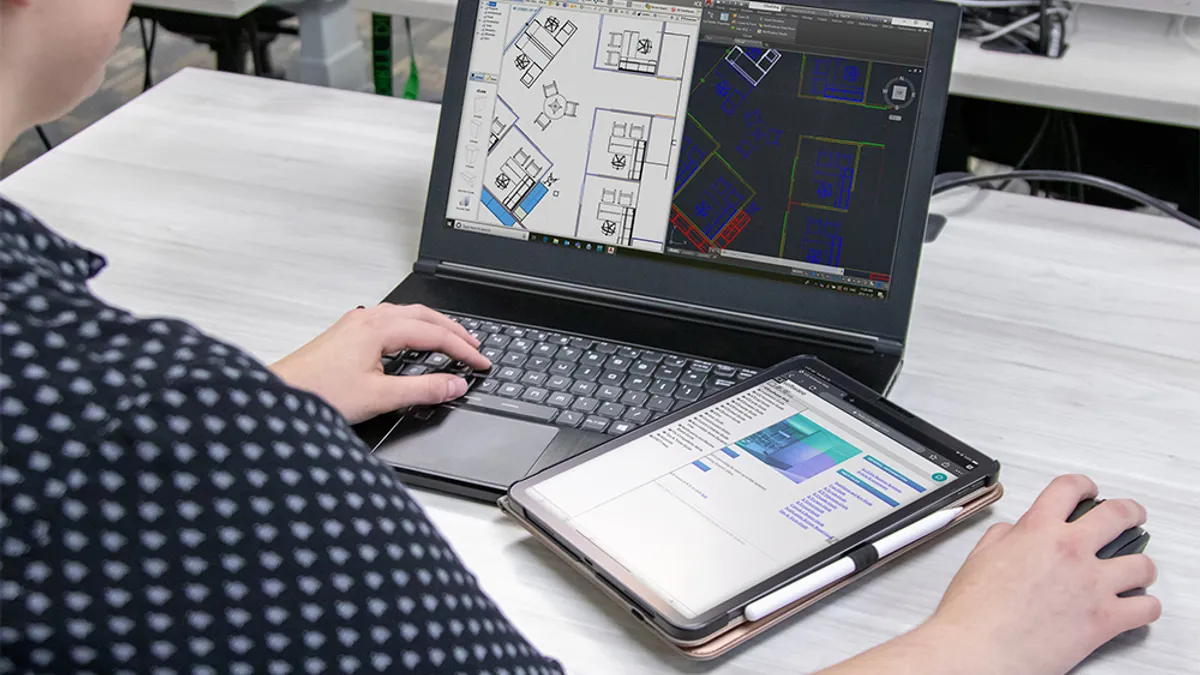We all know the construction industry is understaffed.
By one estimate, 546,000 additional workers are needed to meet labor demands in 2023, on top of the usual pace of hiring. And in the next decade, over 40% of the U.S. sector’s workforce is expected to retire.
Labor shortages like these necessitate a fundamental shift in construction work, “away from on-site construction to doing more work that's modular or involves high tech and automation,” says Alex Carrick, an economist who specializes in construction trends.
Construction roles that embrace digital solutions to increase efficiency — ranging from the use of virtual reality and 3D modeling to prefabricated production of modular interiors — are key to the future of the industry, he explains.
But enhanced efficiency isn’t the only benefit. Carrick says the adoption of tech-enabled systems and processes can also help entice new types of talent to the industry.
“It's always been a harder sell for construction to attract younger workers. Because, if you're given the option of working out in the cold all day versus sitting in someplace that's a whole lot more comfortable, which are you likely to choose?”
For tech-savvy young professionals, greater digital adoption within the industry offers appealing careers in construction. This can include digital twin modelers, virtual reality specialists, as well as other jobs related to automation, AI and even robotics.


Industrialized construction fills labor gaps
If you don’t have the workers you need and want to keep costs down, there is a solution.
“Automate where possible, fix problems virtually during the design phase before they happen in real life and construct what you can off-site,” says Carrick.
“[Digital tools] give you that opportunity to get things right in the planning stage before you undertake the practical work. The smart construction companies recognize this,” he says.
For example, Building Information Modeling (BIM), which is often used to design modular systems, improves both visualization and collaboration long before on-site work begins. And digital twin technology — also utilized by industrialized construction — creates a digital project replica that adapts to changes in real-time.
These tools help reduce errors, which in turn cuts down the need for expensive change orders, Carrick says. And importantly, automation and virtual design tools used when developing modular solutions still leave lots of room for the client’s imagination and vision.
“People used to worry that modular wasn’t as flexible. You can do more creative things than you used to,” Carrick notes, because industrialized solutions are more customizable than people realize.
And, more sustainable. “Because of high-tech laser cutting of materials, you can (also) save on material use,” he says.
Essentially, modular offers the kind of productivity gains (without giving up design freedom) that become not just nice, but necessary when you lack human power.

Appealing career options for young talent
This approach also offers a variety of appealing new career paths for young talent.
“There are so many other job opportunities out there to compete with, construction is really going to have to up its game to attract workers… and there’s going to have to be a groundswell from younger people,” to address the industry’s labor problem, says Carrick.
“The next cohort of workers is more likely to be interested in construction work that includes more digital elements and less outdoor labor,” he says.
There may even be an opportunity to attract talent from demographics who haven’t historically been drawn to on-site work because it can be unpredictable (among other challenges, of course).
“In terms of digitalization, there may be some real advantages in terms of attracting Indigenous workers and women and so on, because you can provide things like 40-hour-a-week work schedules,” he suggests. “People like stability, and they like having set schedules so that they know that they work eight hours a day.”

What does the future of construction work look like?
“The growing use of BIM and other digital products create a whole new niche within the industry,” says John McMullen, from the Modular Building Institute (MBI).
He shares examples of skill sets from other industries that are applicable to these more tech-related construction roles, especially in modular construction.
For instance, if you’re working on a smart building with digital interfaces, that kind of work might be a good fit for “anyone with a technical background, programming background, robotics background — those people are finding great success in modular construction.”
Design and project management skills are a must as well. “There are people who need to be on the front end of a project, to design that project, to share that project, to get stakeholders involved and be able to really have everyone visualize the same end product.”
He also notes that technology enables “more of a collaborative effort between the architect, engineer, builders, manufacturers and even people doing electronics.”

The construction revolution
Construction’s revolution is a remodel, not a rebuild. An increase of tech-related and off-site production roles, doesn’t negate the need for traditional talent, says McMullen.
“Traditional tradespeople are critical, and they always have been,” says McMullen. “I think they always will be. Once you get your computer models… they all need to go into a piece of wood or bolt into steel. There would be no buildings without tradespeople.”
As construction pushes boundaries with greater adoption of modular solutions, McMullen thinks more people will be incentivized to consider a career in the sector.
“Now is the time to show high school students, recent graduates — this is an industry making huge strides in its use of digital. This is a great time to get into the construction industry.”
To learn more about industrialized construction, visit DIRTT.com.






